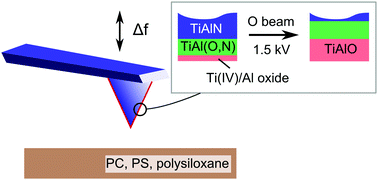Analysis of dispersive interactions at polymer/TiAlN interfaces by means of dynamic force spectroscopy†
Abstract
The structural and electronic origins of the interactions between polycarbonate and sputter deposited TiAlN were analysed using a combined electron and force spectroscopic approach. Interaction forces were measured by means of dynamic force spectroscopy and the surface polarizability was analysed by X-ray photoelectron valence band spectroscopy. It could be shown that the adhesive interactions between polycarbonate and TiAlN are governed by van der Waals forces. Different surface cleansing and oxidizing treatments were investigated and the effect of the surface chemistry on the force interactions was analysed. Intense surface oxidation resulted in a decreased adhesion force by a factor of two due to the formation of a 2 nm thick Ti0.21Al0.45O surface oxide layer. The origin of the residual adhesion forces caused by the mixed Ti0.21Al0.45O surface oxide was clarified by considering the non-retarded Hamaker coefficients as calculated by Lifshitz theory, based on optical data from Reflection Electron Energy Loss Spectroscopy. This disclosed increased dispersion forces of Ti0.21Al0.45O due to the presence of Ti(IV) ions and related Ti 3d band optical transitions.



 Please wait while we load your content...
Please wait while we load your content...